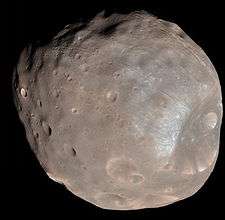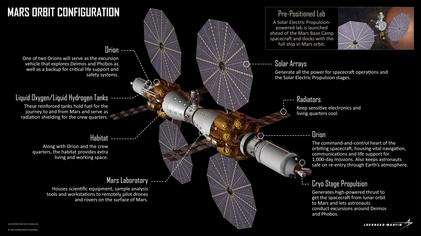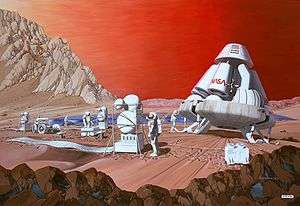Mars Base Camp
 | |
| Function | Crewed Mars laboratory orbiter/interplanetary spacecraft |
|---|---|
| Manufacturer | Lockheed Martin |
| Country of origin | United States |
| Launch history | |
| Status | Under study |
| Notable payloads | Orion MPCV |

Mars Base Camp (MBC) is a crewed Mars laboratory orbiter concept under study that was commissioned by NASA from Lockheed Martin in US.[1] It would use both future and proven concepts as well as the Orion MPCV, also built by Lockheed Martin.
The Mars Base Camp concept is being proposed to NASA as a possible version of the Deep Space Transport, a crewed interplanetary spacecraft to support science exploration missions to Mars of up to 1,000 days.[2] [3] It would be part of a larger architecture that includes the Lunar Orbital Platform-Gateway space station.[3] As of April 2018, the Mars transit vehicle is still a concept to be studied, and NASA has not officially proposed the mission in an annual U.S. federal government budget cycle.[4][5]
The purpose of MBC would be to conduct real-time telerobotic science, both in Mars orbit and on the surface of its moons (Deimos and Phobos), and serve as a proving ground in preparing humans for future missions to the Martian surface.
History
The concept was published in May 2016 by Lockheed Martin, and it is a design for a spacecraft for carrying humans to Mars orbit and conducting operations in Mars orbit.[6] Mars Base Camp harnesses many NASA technologies in development, or technology goals at the time of the 2010s.[7]
In September 2017, the plan was updated including a concept for a reusable crewed shuttle called MADV (Mars Ascent Descent Vehicle), which would connect to the MBC Mars space station.[8]
Vehicle
Mars Base Camp lays out a proposed technology road map to support NASA's Journey to Mars through the Deep Space Transport and the Lunar Orbital Platform-Gateway.[2] The main systems and modules are:[1][9][10][11]
- Orion MPCV - Command-and-control heart of the orbiting spacecraft, housing vital navigation, communications and life support for extended missions.
- Solar arrays - Generate the power for spacecraft operations and solar electric propulsion engines.
- Radiators - Regulate heat of electronics and crew habitation quarters.
- Cryogenic propulsion stage - Provide thrust for injection trajectory burns from the Moon heading to Mars. In addition, the propulsion stage will have the capability to provide maneuverability via impulse burn thrusters for excursions to Deimos and Phobos. During these missions, the Cryogenic Propulsion Stage will transport Orion, a Service Module, and Excursion Module for the purpose of delivering scientist-astronauts to the satellite surfaces.
- Laboratory - Houses scientific equipment, sample analysis tools and workstations to remotely pilot drones and rovers on the Martian surface.
- Habitat - Provides additional living quarters for crew, as well as consumables storage, radiation protection, and an exercise equipment.
- Excursion Module - Module designed to house one or multiple excursion vehicles to be utilized by crews performing scientific work on the surface of the Martian moons.

Proposed timeline for the Gateway and Mars transport vehicle
| Year | Vehicle assembly objective | Mission name | Launch vehicle | Human/robotic elements |
|---|---|---|---|---|
| 2022 | Start of Lunar Orbital Platform-Gateway assembly by launching the Power and Propulsion Element (PPE)[12] | EM-2 | Space Launch System, Block 1B | Crewed |
| 2024 | Gateway Habitat module launch and mating to PPE in cislunar space[13] | EM-3 | Space Launch System, Block 1B | Crewed |
| 2025 | Habitat and logistics resupply[14] | EM-4 | Space Launch System, Block 1B | Crewed |
| 2026 | Orion capsule (crew 4) delivers the airlock module to the Gateway | EM-5 | Space Launch System, Block 1B | Crewed |
| 2027 | Deep Space Transport (DST) to the Lunar Gateway[15] | EM-6 | Space Launch System, Block 1B | Uncrewed |
| 2027 | DST checkout mission[15] | EM-7 | Space Launch System, Block 1B | Crewed |
| 2028 | DST Cargo logistics and refuelling[15] | EM-8 | Space Launch System, Block 1B | Uncrewed |
| 2029 | DST one year cruise test (shakedown cruise) in cislunar space[15] | EM-9 | Space Launch System | Crewed |
| 2030 | Cargo DST logistics and refuelling mission[15] | EM-10 | Space Launch System | Uncrewed |
| 2033 | DST cruise for injection into Mars orbit[15] | EM-11 | Space Launch System | Crewed |
References
- 1 2 "Mars Base Camp". Lockheed Martin. Retrieved 2016-09-01.
- 1 2 "MARS BASE CAMP UPDATES AND NEW CONCEPTS 68th International Astronautical Congress (IAC)" (PDF). Lockheed Martin. 2017. Archived from the original (PDF) on 29 September 2017.
- 1 2 Mars Base Camp - Habitats. Lockheed Martin.
- ↑ Cislunar station gets thumbs up, new name in President’s budget request. Philip Sloss, NASA Spaceflight. 16 March 2018.
- ↑ NASA evaluates EM-2 launch options for Deep Space Gateway PPE. Philip Sloss, NASA Spaceflight. December 4, 2017.
- ↑ Cichan, Timothy; Bailey, Stephen A.; Antonelli, Tony; Jolly, Steven D.; Chambers, Robert P.; Clark, Benton; Ramm, Steven J. (2017-12). "Mars Base Camp: An Architecture for Sending Humans to Mars". New Space. 5 (4): 203–218. doi:10.1089/space.2017.0037. ISSN 2168-0256. Check date values in:
|date=(help) - ↑ Cichan, Timothy; Bailey, Stephen A.; Antonelli, Tony; Jolly, Steven D.; Chambers, Robert P.; Clark, Benton; Ramm, Steven J. (2017-12). "Mars Base Camp: An Architecture for Sending Humans to Mars". New Space. 5 (4): 203–218. doi:10.1089/space.2017.0037. ISSN 2168-0256. Check date values in:
|date=(help) - ↑ "Lockheed Martin Unveils Sleek, Reusable Lander for Crewed Mars Missions". Space.com. Retrieved 2018-07-20.
- ↑ "Want Humans on Mars? Start With a Martian Space Station". National Geographic. Retrieved 2016-05-19.
- ↑ "Lockheed Martin building an orbiting Mars base to send humans to Red Planet by 2028". International Business Times. Retrieved 2016-05-19.
- ↑ "Lockheed Martin Wants To Send Humans To Mars In 12 Years". Popular Science. Retrieved 2016-05-19.
- ↑ Daines, Gary (December 1, 2016). "Crew Will Mark Important Step on Journey to Mars". Nasa.gov. Retrieved 2 January 2018.
- ↑ Foust, Jeff (10 March 2017). "NASA moving ahead with plans for cislunar human outpost". SpaceNews. Pocket Ventures, LLC. Archived from the original on 11 March 2017. Retrieved 11 March 2017.
- ↑ Gebhardt, Chris (April 6, 2017). "NASA finally sets goals, missions for SLS – eyes multi-step plan to Mars". NASASpaceFlight.com. Retrieved August 21, 2017.
- 1 2 3 4 5 6 Finally, some details about how NASA actually plans to get to Mars. Eric Berger, ARS Technica. 28 March 2017.
External links
| Wikimedia Commons has media related to Lockheed Martin. |
